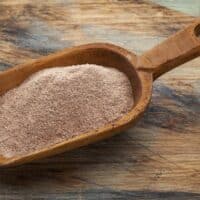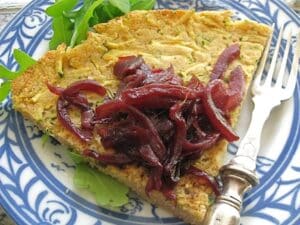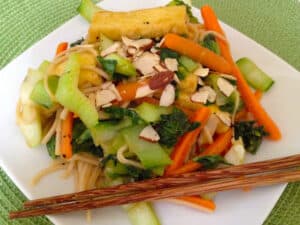Although these teff crêpes don’t have quite the same texture or pronounced sourness typical of injera, they make a good stand-in on days when you want Ethiopian food quickly and don’t have time for the fermentation process or access to commercial injera. They have a slightly spongy-stretchy texture, with a small bit of tang from the yogurt and vinegar, and work well for scooping up sauces and stews. Recipe and photo from Teff Love: Adventures in Vegan Ethiopian Cooking by Kittee Berns © 2015, Book Publishing Company, reprinted by permission. For complete how-to on making authentic Ethiopian injera (the spongy moist flatbread shown in the photo, refer to the aforementioned book!
Recipe

Quick Teff Crêpes
Ingredients
- 1 cup teff flour any variety
- ½ cup chickpea flour
- ½ tsp baking soda
- ½ tsp salt
- 2 cups carbonated water
- ⅔ cup unsweetened plain vegan yogurt
- 6 tbsp apple cider vinegar
Instructions
- Preheat a nonstick skillet (see cooking tip) over medium heat.
- Put the teff flour, chickpea flour, baking soda, and salt in a medium bowl and whisk vigorously to combine and to beat out any lumps in the chickpea flour.
- Add the carbonated water and vegan yogurt and whisk well to combine. When the griddle is hot, whisk in the vinegar to combine. The batter will rise and foam, and the consistency will be thin and reminiscent of chocolate milk.
- Form each crêpe by using a ⅓ cup measure to scoop the batter from the bottom of the bowl and pour it into a disk on the hot pan. Use a spoon to quickly and lightly smooth the batter into a 6-inch disk, starting in the center and working in concentric circles until you reach the edges (keep the center of the crêpe the thickest and the edges the thinnest; the crêpe should be between ⅛ and ¼ inch thick).
- Cover and cook for 1 minute. The crêpe should be dry on the top with a smattering of little holes over its surface. Uncover and continue to cook the crêpe without turning it for 1 to 1 ½ minutes. The total cooking time for each crêpe should be 2 to 2 ½ minutes. When fully cooked, the crêpe should be dry on top with a few air-bubble holes, and the bottom should be firm, smooth, and lightly browned.
- Depending on your cookware and stove, you’ll need to adjust the heat to achieve this result. Use a flat, flexible spatula to loosen and release the crêpe, and then quickly transfer it to a plate and cover with a clean, dry tea towel.
- Repeat the cooking process until all the batter has been used. As the crêpes are made, stack them on top of each other and keep them covered with the towel so they don’t dry out.
- As they cool, the crêpes will develop a spongy-stretchy texture. Let them rest until they’re room temperature, then wrap the stack loosely in a clean, dry tea towel and seal it in a ziplock bag until serving time.
- Be sure the crêpes are completely cool or the bag will collect moisture and they’ll spoil. If you notice any condensation, open the bag to air it out.
Nutrition
Cooking Tips
- For the best success, I recommend cooking these crêpes on a flat, anodized griddle or pan. If you find the crêpes are sticking as they cook, mist the pan with a small amount of oil. Keep in mind, just as with traditional teff injera, the first one cooked is usually a throwaway or a treat for the cook.
- Halve this recipe if you’d like a smaller yield, and for the best results, eat these the same day they’re prepared.
Nutrition Information
Per crêpe: 45 calories; 2g protein, 1g fat; 8g carbs; 2g fiber ; 97mg sodium
More
Visit Kittee Berns at Cake Maker to the Stars.
- Here are more Global Flatbreads.






G C says
The crepes were delicious! Thanks for the recipe! Just wondering how long you can keep them in the zip lock bag (not refridgerated)?
Thanks!